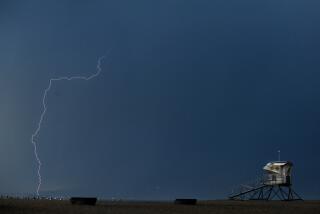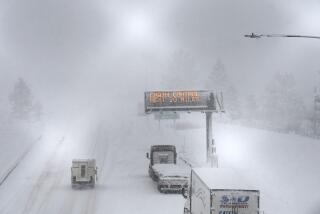Winds Damage Mojave Desert Homes
- Share via
JOSHUA TREE, Calif. — Tornado-like winds ripped the roof from a home and damaged about 10 houses near Yucca Valley as another series of powerful thunderstorms battered the Mojave Desert on Thursday afternoon.
K.D. Crawford said she watched as a funnel cloud dipped toward the ground from black thunderheads that filled the sky.
“It looked like a huge dust devil, gray and spinning and filled with debris,” Crawford said. “There was a lot of noise, and heavy rain and hail the size of walnuts. It was scary.”
Sheriff’s deputies said flash floods blocked several roads as downpours drenched the desert 100 miles east of Los Angeles, but there were no reports of injuries. Forecasters said there could be more thunderstorms, with damaging winds, lightning and flooding, again today.
Thunderstorms have repeatedly hammered desert towns in the last two weeks, especially the communities of Yucca Valley, Joshua Tree and Twentynine Palms in the Morongo Basin north of Palm Springs. Even after Thursday’s lashing, large flashes of lightning illuminated the desert, causing some residents to worry more trouble was in store.
“We’re getting hit by these storms one after another,” said John W. Carroll, who lives next door to the house that lost its roof. “I’m hoping all this comes to an end pretty soon.”
Flash floods swept three people to their deaths in Twentynine Palms on Aug. 26 and swamped at least 30 homes with mud and debris. There were more flash floods the next day.
On Aug. 20, floods furrowed the desert from the Antelope Valley to Las Vegas, forcing the closure of Interstate 15 and stranding drivers in rivers of mud. A state of emergency was declared in Yucca Valley and widespread damage was reported in Joshua Tree.
On Thursday, skies darkened, thunder rumbled and roaring winds engulfed Carroll’s Joshua Tree neighborhood.
“It got blacker and blacker and the winds got stronger and stronger,” Carroll said. “It was a wild afternoon.”
Carroll, 77, said that although his home escaped serious damage, debris from the house next door littered his yard. Fire officials said the winds also tore off a garage door and knocked down a power pole. Nearby homes lost shingles and were scarred by flying debris.
“I’ve been here 14 years, and this is the worst it’s ever been,” said Frank Blauvelt, 75, who lives near Carroll. “We’re down, but we’re holding our own.”
Witnesses said they watched in amazement as a funnel touched down in the playground of an elementary school a short distance away and watched anxiously as it moved through their neighborhood. Children at the school were inside at the time and none were injured. Neighbors said they were surprised that the school building had escaped damage. When the funnel finally left the neighborhood, it’s path was marked by a ragged line of Joshua trees that had been snapped off at the base.
Lois and Ed Becker said they had watched the funnel touch down at the school and then climb a hill toward their street half a mile away.
“It was a gigantic dust wall, just dirt 100 feet wide, and it curled all around our house,” Lois Becker said. They waited for “what seemed like forever” and then ran outside. Four large trees in their side and front yards had been toppled, yet “the storm stopped right at the edge of the driveway,” she said.
“I hope this never happens again in my life.”
The National Weather Service said heavy thunderstorms are not uncommon in Southwestern deserts at this time of year, and the fact that Morongo Valley has been hit repeatedly was just a case of bad luck.
“It’s just that all the dynamics came together at the same place several times,” said Don Whitlow, a Weather Service meteorologist in San Diego. “There have been a lot of these storms all over the place.”
Tim McClung, another Weather Service meteorologist, said winds circulating clockwise around persistent high pressure to the north and east pull warm, moist air from Mexico into the deserts of New Mexico, Arizona, Nevada and California during July, August and early September.
He said afternoon temperatures of 100 degrees or more on the surface of the desert push this moist air up to 20,000 feet or more, where it cools and condenses into sudden, wind-swept downpours.
Whitlow said his office received several reports of tornados Thursday. He said evidence of cyclonic damage on the ground must be found before it can be determined whether Thursday’s gusting winds were, in fact, tornados.
Whitlow stressed that tornados in California, while damaging, are much smaller and less powerful than the devastating cyclones that strike the Midwest. Midwestern tornados stem from collisions between huge systems of cool, dry air from the northern plains and warm, moist air from the Gulf of Mexico.
Whitlow said there is a chance of more desert thunderstorms today, “but that should be the end of it for the foreseeable future.”
“These things usually end by the middle of September,” he said. “That could be all there is this year.”
More to Read
Sign up for Essential California
The most important California stories and recommendations in your inbox every morning.
You may occasionally receive promotional content from the Los Angeles Times.











